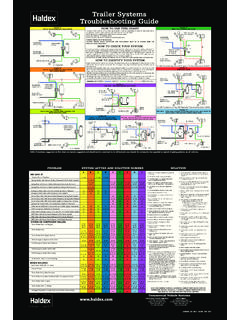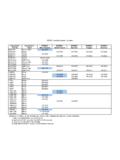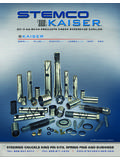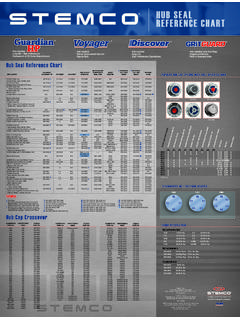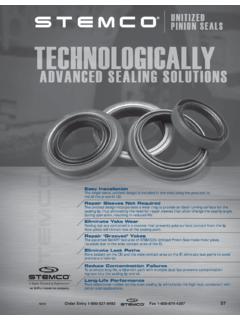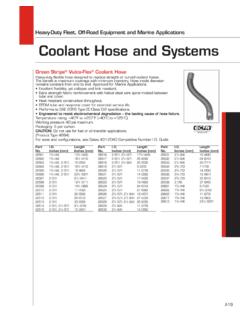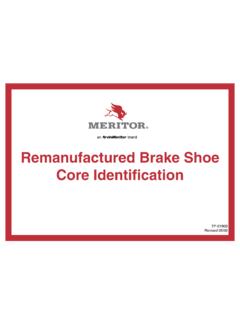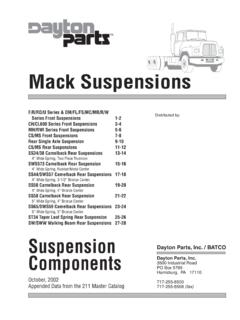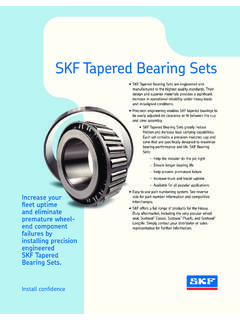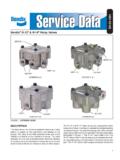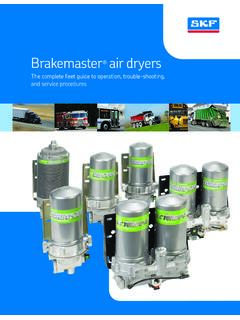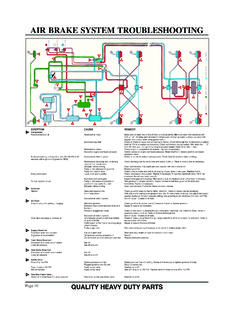Transcription of SD-01-333 Bendix Tu-Flo 550 Air Compressor
1 1 SD-01-333 Bendix Tu-Flo 550 Air CompressorBENDIX Tu-Flo 550 AIR Compressor (CROSS SECTION) Bendix Tu-Flo 550 AIR Compressor (EXTERIOR)AIR DISCHARGEWATER OUTLETPIECE RINGSPISTONCRANKSHAFTCONNECTINGRODINLET VALVE SEATUNLOADERINLET VALVECYLINDERHEADEND VIEW OF CYLINDER HEADDISCHARGEVALVE SPRINGDISCHARGEVALVEDISCHARGEVALVE STOPAIR INLETCRANKCASEINLETINLET VALVESPRINGDESCRIPTIONThe function of the air Compressor is to provide and maintain air under pressure to operate devices in the air brake and/or auxiliary air systems. The Bendix Tu-Flo 550 Compressor is a two cylinder single stage, reciprocating Compressor with a rated displacement of cubic feet per minute at 1250 Compressor assembly consists of two major subassemblies, the cylinder head and the crankcase. The cylinder head is an iron casting which houses the inlet, discharge, and unloader valving. (See Figure 1.) The cylinder head contains the air inlet port and is designed with both top and side air discharge ports.
2 Three water coolant ports provide a choice of coolant line connections. Governor mounting surfaces are provided at both the front and the rear of the cylinder head. The head is mounted on the crankcase and is secured by six cap screws. The Tu-Flo 550 Compressor is designed such that the cylinder head can be installed in one of two positions which are 180 degrees apart. The crankcase houses the cylinder bores, pistons, crankshaft and main bearings, and provides the fl ange or base mounting SEATUNLOADERCOVERWATERINLET2 OPERATIONThe Compressor is driven by the vehicle engine and is operating continuously while the engine is running. Actual compression of air is controlled by the Compressor unloading mechanism and the governor. The governor which is generally mounted on the Compressor maintains the brake system air pressure to a preset maximum and minimum pressure AND COMPRESSION OF AIR (LOADED)During the down stroke of the piston, a slight vacuum is created between the top of the piston and the cylinder head, causing the inlet valve to move off its seat and open.
3 (Note: The discharge valve remains on its seat.) Atmospheric air is drawn through the air strainer and the open inlet valve into the cylinder (see Figure 4). As the piston begins its upward stroke, the air that was drawn into the cylinder on the down stroke is being compressed. Air pressure on the inlet valve plus the force of the inlet spring, returns the inlet valve to its seat and closes. The piston continues the upward stroke and compressed air pushes the discharge valve off its seat and air fl ows by the open discharge valve, into the discharge line and to the reservoirs (see Figure 5). As the piston reaches the top of its stroke and starts down, the discharge valve spring and air pressure in the discharge line returns the discharge valve to its seat. This prevents the compressed air in the discharge line from returning to the cylinder bore as the intake and compression cycle is MACK(MACK STYLE)DETROITDIESELAIR INLETWATERUNLOADER COVER PLATEAIR DISCHARGEWATERAIRDISCHARGEGOVERNORWATERM ANUFACTURED BY BENDIXTU-FLO 550 COMPRESSORBENDIX "FOXHEAD"CUMMINSMACKEXTENDEDFIGURE 2 - FLANGE CONFIGURATIONSV arious mounting and drive confi gurations, as shown in Figure 2, are supplied as required by the vehicle engine designs.
4 A nameplate identifying the Compressor piece number and serial number is attached to the side of the crankcase. (Reference Figure 3.)FIGURE 3 - NAMEPLATEFIGURE 1 - CYLINDER HEADCATBASEMOUNT3force the pistons upward and the inlet valves return to their seats. Compression is then & THE AIR BRAKE SYSTEMGENERALThe Compressor is part of the total air brake system, more specifi cally, the charging portion of the air brake system. As a component in the overall system its condition, duty cycle, proper installation and operation will directly affect other components in the by the vehicle engine, the air Compressor builds the air pressure for the air brake system. The air Compressor is typically cooled by the engine coolant system, lubricated by the engine oil supply and has its inlet connected to the engine induction the atmospheric air is compressed, all the water vapor originally in the air is carried along into the air system, as well as a small amount of the lubricating oil as vapor.
5 If an air dryer is not used to remove these contaminants prior to entering the air system, the majority, but not all, will condense in the reservoirs. The quantity of contaminants that reach the air system depends on several factors including installation, maintenance and contaminant handling devices in the system. These contaminants must either be eliminated prior to entering the air system or after they CYCLEThe duty cycle is the ratio of time the Compressor spends building air to the total engine running time. Air compressors are designed to build air (run "loaded") up to 25% of the time. Higher duty cycles cause conditions that affect air GOVERNORPORTAIRINLETPORTINLETVALVEOPENPI STONMOVINGDOWNDISCHARGEVALVECLOSEDGOVERN ORPORTINLETVALVECLOSEDPISTONMOVINGUPFIGU RE 4 - OPERATIONAL-LOADED (INTAKE)FIGURE 5 - OPERATIONAL-LOADED (COMPRESSION)GOVERNORPORTDISCHARGEPORTAI RINLETPORTFIGURE 6 - OPERATIONAL-UNLOADEDDISCHARGEVALVECLOSED DISCHARGEVALVEOPENAIRINLETPORTNON-COMPRE SSION OF AIR (UNLOADED) When air pressure in the reservoir reaches the cut-out setting of the governor, the governor allows air to pass from the reservoir, through the governor and into the cavity above the unloader pistons.
6 The unloader pistons move down holding the inlet valves off their seats (see Figure 6.)With the inlet valves held off their seats by the unloader pistons, air is pumped back and forth between the two cylinders, and the discharge valves remain closed. When air pressure from the reservoir drops to the cut-in setting of the governor, the governor closes and exhausts the air from above the unloader pistons. The unloader springs INLET VALVEHELD OPENBY UNLOADERPISTONAIRDISCHARGEPORTAIRDISCHAR GEPORTUNLOADER PISTON4brake charging system performance which may require additional maintenance. Factors that add to the duty cycle are: air suspension, additional air accessories, use of an undersized Compressor , frequent stops, excessive leakage from fi ttings, connections, lines, chambers or valves, etc. Refer to Table A in the Troubleshooting section for a guide to various duty cycles and the consideration that must be given to maintenance of other INSTALLATIONW hile the original Compressor installation is usually completed by the vehicle manufacturer, conditions of operation and maintenance may require additional consideration.
7 The following presents base LINEThe discharge line allows the air, water-vapor and oil-vapor mixture to cool between the Compressor and air dryer or reservoir. The typical size of a vehicle's discharge line, (see column 2 of Table A in the Troubleshooting section) assumes a Compressor with a normal (less than 25%) duty cycle, operating in a temperate climate. See Bendix and/or other air dryer manufacturer guidelines as discharge line must maintain a constant slope down from the Compressor to the air dryer inlet fi tting or reservoir to avoid low points where ice may form and block the fl ow. If, instead, ice blockages occur at the air dryer or reservoir inlet, insulation may be added here, or if the inlet fi tting is a typical 90 degree fi tting, it may be changed to a straight or 45 degree fi tting. Shorter discharge line lengths or insulation may be required in cold not all compressors and charging systems are equipped with a discharge line safety valve this component is recommended.
8 The discharge line safety valve is FIGURE 6A - SYSTEM DRAWINGFIGURE 6B - DISCHARGE LINE SAFETY VALVEHOLETHREAD installed in the cylinder head ( Tu-Flo 550/750) or close to the Compressor discharge port and protects against over pressurizing the Compressor in the event of a discharge line LINE TEMPERATUREWhen the temperature of the compressed air that enters the air dryer is within the normal range, the air dryer can remove most of the charging system oil. If the temperature of the compressed air is above the normal range, oil as oil-vapor is able to pass through the air dryer and into the air system. Larger diameter discharge lines and/or longer discharge line lengths can help reduce the air dryer contains a fi lter that collects oil droplets, and a desiccant bed that removes almost all of the remaining water vapor. The compressed air is then passed to the air brake service (supply) reservoir. The oil droplets and the water collected are automatically purged when the governor reaches its "cut-out" DryerReservoir DrainService Reservoir(Supply Reservoir)CompressorGovernor(Governor plus Synchro valve for the Bendix DuraFlo 596 Compressor )Discharge LineOptional Ping TankOptional Bendix PuraGuard QC Oil Coalescing FilterThe Air Brake Charging System supplies the compressed air for the braking system as well as other air accessories for the vehicle.
9 The system usually consists of an air Compressor , governor, discharge line, air dryer , and service 7 - LUBRICATIONOILINLET2. Naturally aspirated Engine Air Cleaner - Compressor inlet is connected to the engine air cleaner or the vacuum side (engine air cleaner) of the supercharger or turbocharger. 3. Pressurized induction - Compressor inlet is connected to the pressure side of the supercharger or turbocharger. See the tabulated technical data on page 14 of this manual for specifi c requirements for numbers 2 and 3 above. If a previously unturbocharged Compressor is being turbocharged, it is recommended that the inlet cavity screen (238948) be installed with an inlet gasket (291909) on both sides of the screen. WATERINOR(1 PORTONLY)WATEROUTOR(1 PORTONLY)WATER OUTWATEROUTWATERINWATERINFIGURE 8 - COOLINGFor vehicles with accessories that are sensitive to small amounts of oil, we recommend installation of a Bendix PuraGuard QC oil coalescing fi lter, designed to minimize the amount of oil vehicle's engine provides a continuous supply of oil to the Compressor .
10 Oil is routed from the engine to the Compressor oil inlet. An oil passage in the Compressor crankshaft allows oil to lubricate the connecting rod crankshaft bearings. Connecting rod wrist pin bushings and crankshaft ball bearings are spray lubricated. An oil return line connected from the Compressor drain outlet to the vehicle engine crankcase allows for oil return. On fl ange mounted models the oil drains back directly to the engine through the mounting fl fl owing through the engine compartment from the action of the engine s fan and the movement of the vehicle assists in cooling the Compressor . Coolant fl owing from the engine s cooling system through connecting lines enters the head and passes through internal passages in the cylinder head and is returned to the engine. Proper cooling is important in maintaining discharge air temperatures below the maximum recommended 400 degrees 8 illustrates the various approved coolant fl ow connections.
